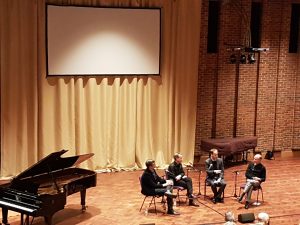90 years ago, on 9 February 1928, the remarkable First World War drama, The Guns of Loos, received its press screening in London. Trade journal, The Bioscope, declared the film to be ‘as convincing a picture of modern warfare as has yet been shown on the screen’.
Coinciding with this anniversary, and as part of the University of Southampton’s Great War: Unknown War centenary events, the film was screened again at Turner Sims, accompanied by world renowned composer and pianist Stephen Horne, performing his original score, with percussionist Martin Pyne. I had the pleasure of introducing the film.
This British silent film portrays events surrounding the calamitous 1915 Battle of Loos, and features spectacular battle scenes and high drama on all fronts, as a munitions strike endangers supplies for soldiers at the front.
The film focuses on two soldiers, John Grimlaw (Henry Victor) and Clive (Donald McArdle), who find their mental and physical fortitude tested on the battlefield. The men are also fighting to win the love and respect of a Red Cross nurse, Diana, played by Madeleine Carroll, here making her screen debut. The ensuing events expose the impact of the war on all involved.
Two qualities were prominent in the film’s promotion: spectacle and authenticity, with some of the events based on director Sinclair Hill’s own war experience. Four guns were loaned to the production by the War Office including actually used in the Battle itself. Of the 250 men reported to have taken part in the re-enactment – filmed in West Thurrock – many were unemployed ex-soldiers supplied by the Ex-Service Men’s Association. Much was made of the appearance of Daniel Laidlaw, the almost mythical ‘Piper of Loos’, who played himself in the film. Laidlaw had won the VC and the Croix de Guerre for playing his regiment ‘over the top’, and Horne’s score includes an actual recording of Laidlaw playing his pipes, adding an eerie and poignant note to this moment in the film.
To literally magnify the film’s impact, on some screens in Britain, the film was screened using the Magnascope process, where a special lens was placed in front of the projector to suddenly enlarge the image across the cinema auditorium, immersing the audience into the spectacle.
When shown a print of the film, David Lloyd George, Minister of Munitions at the time of the Battle, was reported to have exclaimed to its director: ‘In wartime this film would have been worth a division’. While the film might have had propaganda value, its 1928 audience, looking back on the war through the lens of the 1926 General Strike, would have been well aware of its topicality. While men had been dying at the Front in 1915, many were ill or dying at home due to poverty and poor housing conditions. War injuries were visible and commonplace in the 1920s, meanwhile, and awareness was growing of ‘shell shock’ – Piper Laidlaw even endorsed the nerve tonic ‘Phosferine’ during the film’s release. The film tells us as much about the post-war context as about the war itself.
The manager of Stoll Studios, which made the film was clear on the film’s ambition: ‘with the advance of the art of cinematography we may expect to see something which will not only vie with foreign productions, but which will outstrip them, in story value, in acting, in direction and in photography’.
On 11 February, the large audience at Turner Sims were clearly moved by the powerful live score which really brought to life the film’s remarkable imagery and performances. Present in the audience were relatives of men who had fought at the Battle, who offered their own insight into the legacy of the battle. Joining me in a Q&A session afterwards were the Film department’s Dr Michael Hammond, an expert on cinema and WWI, plus the musicians. The many questions explored the film’s reception and the extraordinary effect of the music, with several audience members conveying the impact of viewing what was evidently the first silent film they had seen with live music.
Through performances such as this, The Guns of Loos can be appreciated as a classic that we should all know about.
The Great War: Unknown War’s ‘Silent Film Fortnight’ continues at Turner Sims, and promises to be an illuminating and highly engaging exploration of both the events of the war and the experience of cinema itself.

Picture Courtesy of Kevin Appleby
